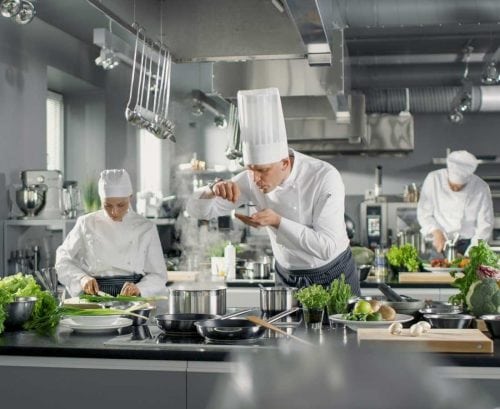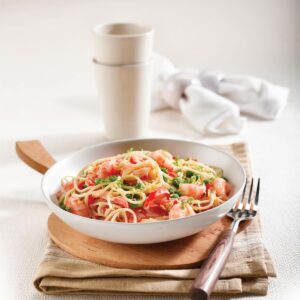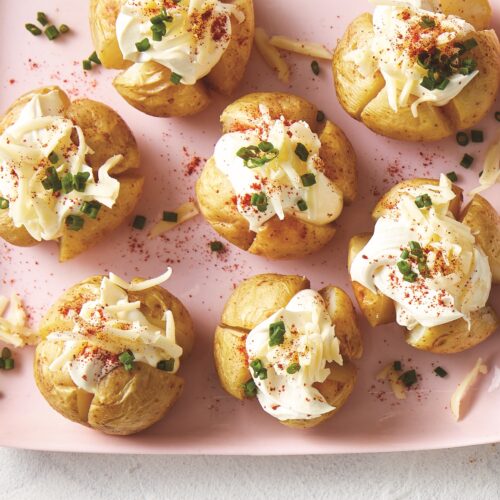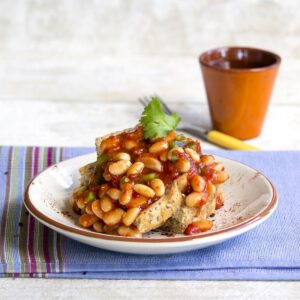
Chef Jenny Woodberry shares tips and tricks designed to make preparing healthy meals as easy as possible. Here she outlines the best way to structure a meal prep session through the art of multi-tasking.
When I worked in a professional kitchen, we would divide each dish into separate cooking elements in order to ‘plate up’ everything at the same time. I use a similar method when preparing meals for the week, structuring the process into five easy steps:
- Marinating – Meats/protein
- Roasting – Starches, vegetables and meat
- Simmering – One-pots and carbs
- Flash – Quick-cook items
- Garnish – Finishing touches
Structuring your cooking in this way is a total GAME CHANGER. I’m really not exaggerating – learning how to multi-task is such a useful skill and will save so much time. So, let’s go!
1.The marinade stage
Start with the marinade. Whether it’s meat, tofu, halloumi or your choice of protein, you want the flavours of the marinade to infuse for as long as possible – for maximum flavour. It’s important to start with the jobs that take the longest first, so you can get on with cooking everything else in the meantime.
Know-how: If you’re cooking meat or fish, it’s safer to do this first. By prepping them at the beginning, you can wipe down all your surfaces, avoiding cross-contamination, before starting to prepare anything else.
Use separate bowls to make the various marinades you require for your menu. Some of my favourites are tandoori spice mixed with Greek yoghurt and lemon juice or a blend of fresh garlic, herbs, lemon, chilli and olive oil.
Then, dice up your choice of protein – chicken breast, fish, braising steak, halloumi, tofu – and coat them in your marinade. You can skip the dicing stage completely, if you like! Just marinade whole and set aside.
Great, step one done.
2. Time to get roasting
Next, think about the ingredients that will require cooking in the oven. Roasting foods can take a little longer – especially starchy foods such as potatoes, butternut squash, parsnips or carrots – so you want to get these in the oven as soon as possible.
Tip: if you have a lot of things to roast at the same time, use foil or baking parchment to save space. I often divide different ingredients into small parcels so that I can fit multiple things onto one baking tray.
Set your oven to a high heat to start off with – around 200°C – and roast any big starchy vegetables such as sweet potato wedges, first. Once these foods are about 15 minutes away from being cooked, drop the temperature down to 180°C and pop your marinated ingredients in the oven, too.
Tip: if you’re baking meat or fish, wrap them in foil to lock in the flavour and ensure a moist texture.
Once everything is cooking happily in the oven, set a timer and move on to step three.
3. Boil and bubble
Now, hop on over to the hob! If you’re making a one-pot recipe, such as a chilli or curry, then get this on now. Quick hacks like pre-chopped onions and garlic paste are a great way to make this more efficient.
If you’re cooking rice or any other grains, then pop a pan of water on to boil, too. Just make sure to rinse them under lots of cold water to get rid of any excess starch or scum, then follow the packet instructions to cook correctly.
Tip: try cooking grains in stock rather than just water for extra flavour. Adding aromatics such as bay leaves, cardamom, cloves and cinnamon sticks to the water, too, will impart even more flavour without having to use lots of salt.
Finish cooking yours grains before moving on to step four, as you will need some space on the hob. Don’t forget to keep an eye on what’s roasting in the oven too!
4. Flash in the pan
When I say ‘flash’ I’m referring to foods that take very little time to prepare and cook, such as steak, halloumi or veggies.
Put a couple of pans over a high heat, if you have a few flash items, and add a splash of oil or cooking spray to make sure your food doesn’t stick.
Tip: try adding a little acid when cooking ‘flash’ foods – like lemon juice or balsamic vinegar – to deglaze the pan and add flavour. For example, just before a steak is cooked, adding a dash of lemon juice to the pan will deglaze all those caramelised bits ‘stuck’ to the bottom and will coat the meat instead.
Finally, leave to cool. If you like, use a piece of kitchen roll or cloth to absorb any excess oil.
5. Give it a garnish
By now, everything should be cooked, cooled and ready to be organised into containers ready for the week ahead. Now, it’s time for the finishing touches!
Garnishing with fresh herbs, chilli flakes, lemon/lime wedges, dressings, feta, toasted seeds and more, really add another dimension of flavour to your meals. It only takes a minute and will take your meals to a whole new level, so do have a play around with different toppings.
Tip: keep fresh herbs like parsley, coriander, basil and mint to hand for a final flourish. To find which ones to use and when, I’ve put a quick guide together:
Parsley
Parsley is really versatile and works in most dishes because its flavour isn’t over-bearing. Use it to add a lovely, fresh element and lift any ingredients that may be lacking in flavour.
Pairs well with: garlic and lemon.
Coriander
This aromatic herb is perfect in anything with a little heat! Stir it through curries, spicy rice, chilli con carne and dhals.
Pairs well with: coconut, lime and ginger.
Basil
Be careful with basil – you can’t chop it as roughly as other herbs as it will bruise and turn a horrible shade of black! Add to dishes right at the end of cooking.
Pairs well with: tomato-based dishes.
Mint
Don’t go too crazy with mint as it’s quite strong but adds a lovely, light freshness. It’s a really nice one in salads too – try tossing through couscous for a quick and easy salad.
Pairs well with: halloumi, feta or mixed with Greek yoghurt and black pepper for a cooling dip.
Once you’ve completed every stage, divide everything up into storage containers. This is my favourite part of meal prep – it’s so satisfying to watch every element come together after all your hard work.
I hope this guide provides the building blocks you need to multitask like a professional chef, save yourself some time and to be more adventurous with your cooking. Healthy meals really don’t need to be difficult.
www.healthyfood.com










